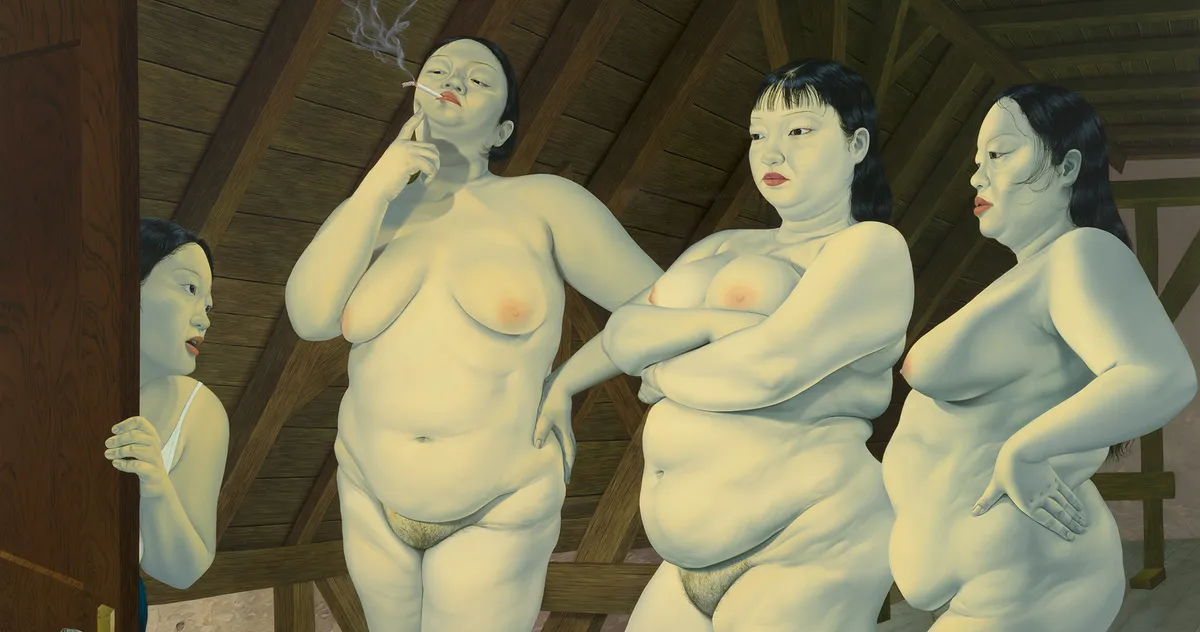Copyright Vulture

Usually, I dislike surfaceless hyperrealism; to me, it’s an optical dead end. But 27-year-old Sasha Gordon’s new cycle of self-portraits at David Zwirner, “Haze,” is an exception. The star of the show is a seven-foot-tall painting called Pruning, in which Gordon is trapped in a Houdini-like tank of water, forced down by a faceless female. (Doubles proliferate in Gordon’s work — could the faceless torturer also be her?) Bubbles of air escape her mouth while her knees press against the aquarium glass until it cracks. The tank’s rusting iron frame doubles as metaphor: the strictures of gender and race that imprison her. This is not identity politics gussied up for the market, not more virtue signaling. These canvases are too strange and slippery for that. The lighting is theatrical, colors lurid, bodies vivid. The eroticism is undeniable, never safe or consumable. Gordon weaponizes sexuality, turning it inside out until it disorients. Born to a Polish American father and an immigrant Korean mother, Gordon has admitted, “I had a difficult relationship with my Asian identity,” adding that she often felt “disconnected from myself.” Growing up a queer Korean Jewish American in Westchester County produced a schism in which she was both fetishized and rendered invisible. In “Haze,” Gordon uses her body to stage a story about how identity is scripted and distorted — often by herself. Gordon plays all the roles — victim and villain, the stabbed and the stabber — laying bare how Asian women have internalized contradictory ideals: docile yet hypersexual. She leans hard on horror and cinematic tropes of survival. In It Was Still Far Away, Gordon embodies the “final girl” — the resourceful lone survivor of slasher films and atomic fallout. A mushroom cloud behind her glows in radioactive orange-reds. But she seems coolly oblivious, clipping her toenails with her headphones on. In Husbandry Heaven, her protagonist is force-fed by an antagonist with wrinkled waxen skin. Here, beauty becomes literal violence as her mouth is pried open, and nourishment becomes punishment. Women are trained to be quiet dolls, then punished when they falter. Gordon pushes these ideas to grotesque extremes, exposing the violence buried inside. Whores in the Attic gives us Gordon peeping up at three towering Asian succubi who regard her with disdain. A Visitation amounts to a double self-portrait, a nearly nude helpless Gordon shoved into a chair by a great naked phantom banshee. In Husbandry, the forced feeding escalates with Gordon being overpowered by three giant Asian shades. In Petrified, a fight to the death unfolds on barren ground. Gordon is tethered by a pubic-hair leash, which extends from her vagina, and is dragged by one of her demon identities. (Gordon has a thing for stringy hair and nail clippings.) Not every canvas lands. The horror conceit occasionally lapses into B-movie costume drama with antagonists that feel more pastiche than myth. Yet when she hits, she hits hard. She paints to free herself from fetishization and the suffocating standards of beauty. She risks melodrama because melodrama is horror’s native tongue. Better too much than too little. Better to scream than to whisper.



